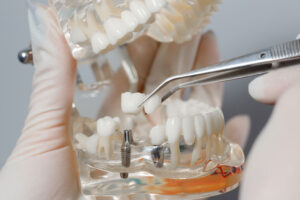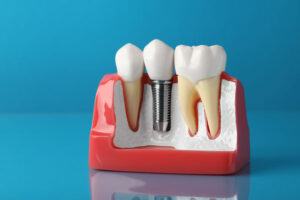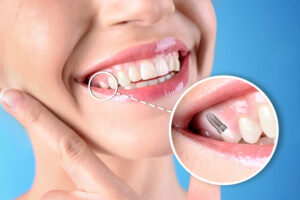When it comes to restorative dentistry, there are few treatments that can do all of the jobs that dental crowns can. They truly are the jack-of-all-trades in the dental world. As a prosthodontist, Dr. Wilhelm can help you understand the diverse job descriptions of dental crowns. Together, you and Dr. Wilhelm can find the option that is right for you.
What Is A Dental Crown?
Simply put, a dental crown is a cap-like structure that is placed on top of a damaged tooth. The crown protects the tooth from further damage and makes it possible for you to use that tooth again. There is another type of dental crown as well. These crowns are placed on top of dental implants. A dental implant is not a replacement tooth but rather a replacement tooth root. It forms the base that gives your crown the stability and support needed to function like a real tooth.
Now that we know what dental crowns are, let’s take a look at what they are used for.
What Do Dental Crowns Treat?
Cracks – A cracked tooth is a dangerous situation. The structural integrity of the tooth has been compromised and is vulnerable to further damage from even lesser forces. A crown is placed on top of the tooth to keep the tooth safe from cracking even more, or from breaking altogether. The crown will restore the function of your damaged tooth as well.
Broken Tooth – The next level of injury after a cracked tooth is a broken tooth. This exposes the inside of your tooth to the elements in your mouth. While this doesn’t seem like something dangerous, we assure you it is. No matter how clean you keep your mouth, there will ALWAYS be bacteria present. If bacteria is able to get into the inner parts of your tooth, they can cause an infection. This infection can lead to a damaged nerve and/or the development of an abscess (pocket of infection in your gums that needs to be drained). It could also cost you your tooth. A crown can seal the tooth and keep the harmful bacteria from reaching your inner tooth. The crown will also keep all of the parts of your broken tooth together and restore its function. In other words, the dental crown will keep your real tooth in your mouth.
Severe Tooth Decay – When tooth decay occurs, it is important to get it taken care of quickly. The longer you let it thrive in your tooth, the more of your tooth it will destroy. Severe tooth decay can leave you with a deteriorated tooth that is too damaged to be fixed with a simple dental filling. In these instances, dental crowns are an effective alternative. The crown will cover the damaged tooth, restore its look and function, and seal out the elements that may cause additional decay.
Crowns are also able to replace a tooth that is too damaged to save. Here are a few of the other restorative uses for dental crowns.
Implant Restoration – When you get a dental implant, you are actually getting a replacement tooth root. A dental crown can be made so that it is more like a real tooth (not hollow). This will let it stand up to the biting forces of your mouth. The crown will be securely fixed to the top of your implant, leaving you with a full smile that will look as good as, or even better than, it ever has.
Fixed Bridge – Two traditional crowns (hollow) are bonded to a replacement tooth and then mounted onto healthy teeth in your smile to “bridge” the gap in your smile. These are great for people who have lost a tooth but don’t want to get a dental implant.
Implant-Supported Bridge – This type of bridge is different from the fixed bridge in that it uses dental implants and implant crowns to keep your bridge in place. Dr. Wilhelm will gently place dental implants into your jawline and then secure a bridge on top. This option is for people who have lost three or more teeth and don’t want to deal with a partial denture.
What Is An Inlay And An Onlay?
Inlays and onlays are types of partial crowns. Dr. Wilhelm may recommend one of these when the damage is too severe for a dental filling but not bad enough to need a full dental crown. An inlay covers the inside of your tooth’s biting surface, and an onlay extends from the inside onto the outer biting surface as well.
Call our Woodbury, MN office today at 651-319-9064 to schedule your appointment and ask about how our crowns can help you.



